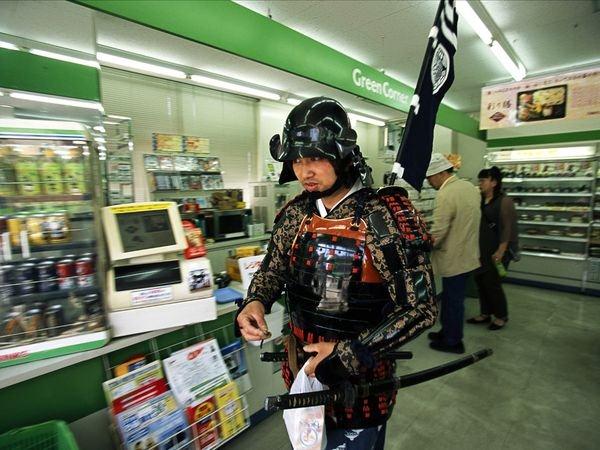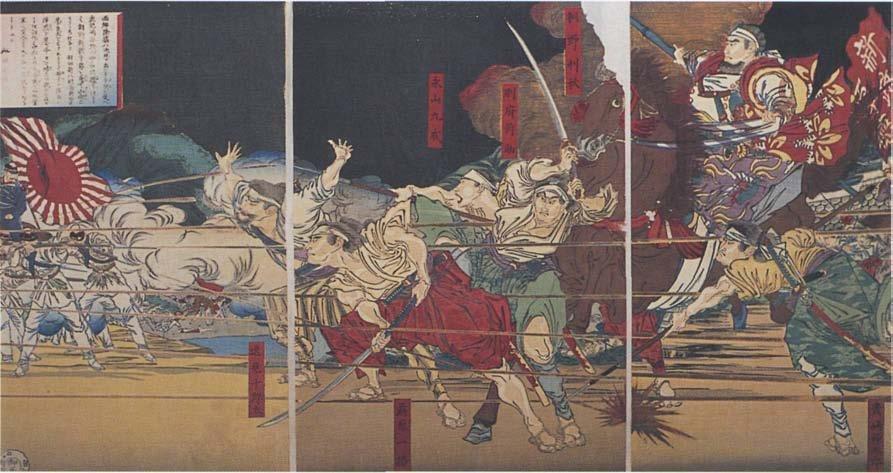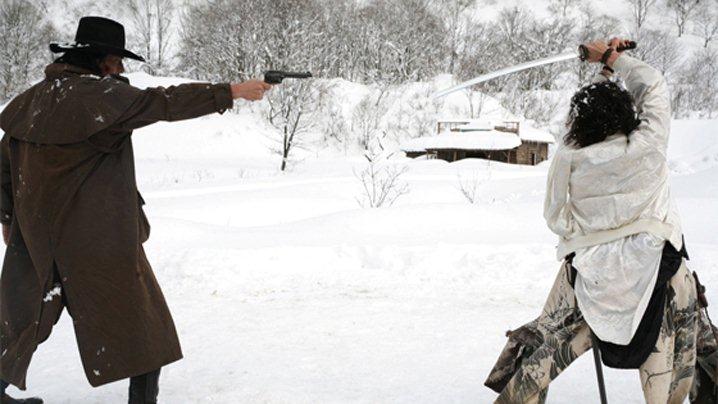
POW! – The battlefield and martial arts – historically speaking
All martial arts originally have a starting point in war. In war, people die, and in war it is about winning in both the short and long term, and preferably as quickly as possible, with the least possible use of resources. War does cost money, but it is also a whole industry in itself. This has been the case throughout the history of the world.
The constant pressure for benefits has led to an arms race. In general, before the 17th century, swords, spears, bows and arrows were the decisive weapons on the battlefield. This changed drastically all over the world with the introduction of firearms, and with the industrial development in the 1800s, this went really fast.
What has never changed in importance in war is the quality of the skills that the individual soldiers have had throughout world history, but indeed also their leaders, which could be clearly understood by reading the first POMW! Article.
In Japan, this fact has been systematized for 1000 years. Leaders and elite fighters were trained from childhood in all competencies with very high level requirements. Regular soldiers were trained in weapons that they could use more quickly with efficiency and minimum effort. Therefore, it was also these soldiers (ashigaru) who were trained in the use of firearms when they came to Japan with the Portuguese in the 1540s. More than 250 Japanese shooting schools arose in the wake of the introduction of firearms into Japan, several of which still exist today.
From 1600 to approx. In 1853, Japan was a closed country, without much contact with the outside world. This also meant that very few modern 19th century European firearms had made it to Japan. On the other hand, the 250 years of isolation was a peaceful cultural and artistic flourishing, and the martial art went more from a martial art (Bujutsu) to an emphasis on the inner clarification process (Budo).
1877 saw the last major civil war battle between the old world; samurai, and modern short-term trained soldiers with firearms and machine guns. This dualistic theme has been depicted in many films and books. 1877 the battle through the Oscar-nominated epic film "The last Samurai", Akira Kurusawa's film; Ran, Kagemusha, Yojimbo and too many of the world's best movies; The Seven Samurai.
The introduction of firearms changed world history and the way of waging war. But one thing firearms still haven't changed is the deciding factor; the quality of the human behind the firearm. After all, it is not the firearm that kills - it is the decision, the clarification and the responsibility of the person who pulls the trigger.
In our system's 1,000-year-long history - and throughout the history of martial arts, this fact is well known. Therefore, the essence is still in martial arts, to learn to know oneself and to be the leader of one's own life through the inner clarification process.
But it is also a fact that today statistically only 1 out of 10-20,000 practitioners reaches the MENKYO (Master of all the martial arts) and 1 out of 1,000,000 practitioners the MENKYO KAIDEN (Initiated master of all the martial arts) degree. Today, there is no other incentive than one's own desire to "go the way - Michi - DO". A student can only do that if this student is 100 % – all the time.
Today it has become a martial art. To make it more manageable and audience-friendly, the old multi-track martial arts systems have been divided into single-track simplified martial arts systems, which are adapted to the 1-3 times weekly needs that 99.9 % of modern martial artists have today. Today we meet people where they are and take them on a journey - as far as they want over time.
Yakami Shinsei-ryu is a multi-track martial arts system that is adapted to the needs and time consumption of the modern world with "Space for everyone, the elite as the exerciser". We have both armed and unarmed curriculum techniques that go back more than 1,000 years.
We have a stated goal that all our members – regardless of age and gender, will have a good opportunity to obtain the degree; SHODEN, Yakami Shinsei-ryu, 3rd dan Sr., Bujutsu Kodosokukai karate-do. We also have the declared goal that some of our members - regardless of age and gender, will have a good opportunity to achieve the degree: JODEN Hiden Yakami Shinsei-ryu, 5th dan. Bujutsu Kodosokukai karate-do.
In Shindenkan we can neither achieve the primary purpose; Get to know yourself and be the leader of your own life, or the secondary purpose; Progress through the Yakami Shinsei-ryu multi-track martial arts system if we exclude tools from our toolbox in advance, limiting ourselves and denying the world's development, history and learning.
Is it wise for an explorer to pre-empt places, things and modern methodologies to reach a stated goal? Is it wise to use a hammer and nails for building a wooden house if you could also choose to use an automatic nail hammer?.
After all, life in its entirety should be unlimited and not limited. It is only your mind that limits your mind. Remember that – it is important for a budoka on the path to self-discovery.

Shindenkan – POMW! – the regeneration
Minouchi Sensei said that the rare thing that could happen is that a modern warrior went from Option III to Option II. This then means that this could only happen before or at densho level iodine. Which then means that this must also apply in reverse, since IN-YO is one. In Shindenkan, JODEN is martial arts master level and experienced level in Yakami Shinsei-ryu, and 5th dan Bujutsu Kodosokukai karate-do level.
This level will mean an absolutely complete elite shooter at the absolute international top level within all types of weapons. However, this is not at all necessary for a good understanding and competence of firearms within Shindenkan and what the purpose of Yakami Shinsei-ryu is. Where is this then?.
Yakami Shinsei-ryu is a complete multi-track martial arts system, with both armed and unarmed skills. In its nature, it is therefore unlimited - i.e. the system goes from limited to unlimited in harmony with the student's development, motivation and goals. We meet people where they are and take them on a journey, and it should continue to be that way.
The only recognized shooting system which is multi-track and which you can train in Denmark is the shooting formula 1; IPSC – International Practical Shooting Confederation. IPSC is worldwide, but still very small compared to other shooting disciplines. It is practical and dynamic shooting from different distances, positions, targets and in motion. It reflects reality as much as possible, which is also the reason why many specialized police and military personnel train in this shooting discipline. IPSC requires the highest shooting license in Denmark; DSF A license, which approx. 1 out of 500 shooters have in Denmark. A DSF A-license corresponds to other countries' range judge licence, and is for experienced shooters. Denmark is the only country in the world where the safety requirements for IPSC shooting require a DSF A license.
At Shindenkan, we perform voluntary and unpaid work for the benefit of our members, the community and others. Because we do this, it doesn't mean we have to do double or triple the work when it's only necessary to do a proper piece of work - once.
We therefore have 5-year strategic plans and management tools to make it easy for ourselves. Martial arts are not limited to just martial arts, as the starting point is and will be the practitioner. The person behind it is full of valuable life experiences from education, work, family, friends and themselves. We of course actively use this in Shindenkan with respect and acceptance for each other, and build on that.
A quick general overview analysis showed that there were approx. 150,000 more or less active shooters in Denmark. It was the norm to train once a week with standardized shooting programs, usually a pack of 25 to 50 shots per week. training lesson. Normal competitive shooters train 1-3 times a week. A normal Danish shooter therefore shoots between 1,000 – 3,000 shots annually with one to two training sessions per week. Active competition shooters shoot maybe 10-15,000 shots/year and normal sponsored top shooters between 20-30,000 shots annually.
These are generally single-track systems where the shooter stands still while the firing program is executed. It differs from IPSC, which is practical shooting with heavy weapons, where you move from shooting position to shooting position and where you decide the shooting program – it is free style. Normally active IPSC shooters shoot 10-15,000 rounds annually. Normal "National team shooters" shoot 30-50,000 shots annually and Denmark's very few internationally sponsored top shooters up to 100,000 shots annually.
History has shown that if a new shooter gets the absolute best starting point and path towards an international top shooter, then this must have the best available shooting instructors and shoot 100,000 good shots in 2-5 years. If we are talking about non-IPSC shooters, this will correspond to what a normal sponsored Danish top shooter shoots in 4 years! Or a normal active competitive shooter shoots in 8-10 years!. Not just to say what a normal Danish shooter shoots in 50-100 years.
On a positive note, a new extremely determined and motivated shooter of 2-3 years can become an international top shooter if this shooter trains several hours every day, shoots 100,000 good shots annually, and is taught by the best available international top shooting instructors.
All in all, quite logical, but also practically impossible if you are not a professional sponsored shooter, soldier or police officer, with shooting as your job responsibility.
According to the 2010 strategic plan, POMW! have been started in the preparatory phase in early 2010 and the next 3-4 years. But it was only started in mid-2011 with a different person in the project than originally optimal and intended.
Kimu Sensei had just finished developing and training the Honbu course instructors in all curriculum and competency courses from 10.kyu (white belt) to 1.dan Yakami Shinsei-ryu (black belt, 2.dan karate-do) in HonbuStrat2010 (2005-2010).
From mid-2011, he was to concentrate on the final development of the long-term competence module courses from 1st dan Yakami Shinsei-ryu (black belt, 2nd dan karate-do) to Joden hiden Yakami Shinsei-ryu (black belt, 5th dan karate-do) according to Honbu Strat15 (2010-2015).
In order to test Minouchi Sensei's statement, the practitioner should be between the martial arts denshograd Joden and Menkyo, and preferably full menkyo for full confirmation of the statement. The practitioner had to be without prior firearms experience - but completely "clean".
Only qualified opportunity in mid-2011 to start the preparatory phase of POMW! was: Kimu Sensei. So it was just up on the horse and off we went. There were no other options, and HonbuStrat15 could not tolerate any more delays if Shindenkan were to reach the finish line.
Kimu Sensei continuously bought a lot of books, DVDs, studied a lot on the Internet, and called a lot of helpful and informative people, so that he could prepare a realistic plan. Fortunately, Denmark's three best international top shooters wanted to use their experience and shooting knowledge, so that the shooting instructor competence criterion could be met, and registration in five shooting associations continuously also became a reality, so flexibility was also achieved and all obligations could be accommodated.
Time was short, since the last DSF A license test of the year was two months after the start of shooting. And with no previous shooting experience, extra hard work had to be done – with all the obligations.
Two months later, the DSF A license came home with a second place in the company of shooters with 5-20 years of shooting experience. Two weeks later, the permanent DSF A license was in house, and within three months from start-up; three matches; two in the USA and one in Denmark, and many richer experiences.
Two milestones have been achieved, so that we can now also concentrate to a greater extent on other obligations. Which is also needed, as not everything in the shooting world is rosy.

POW! is targeted at the TG4 group with 7-12 years of Yakami Shinsei-ryu experience
It is important to point out that POMW! is for the TG4 group – black belts. However, for practical reasons (graduation progression until 2016/17), the first time may be covered by YSK brown belts, as all black belt leadership development seminars will run in cycles of 4 years
There is still only one competency resource in the Shindenkan who can develop and create all competency courses for black belts so that the competency level requirements are met in the over 1,000 year old martial art system. This is Kimu Sensei.
All the KYU courses were very time-consuming with a resource consumption of between 600-1000 hours per course. course, as well as additional resource consumption for training qualified Honbu instructors to carry out the course to a constant standard - all the time.
All black belt courses are considerably more complicated and resource-intensive to develop and construct than the KYU courses, and with just one competence resource in the organization who also has to teach them, it must necessarily be every 4 years. Jens Hanshi-dai's statistics also show that this corresponds very well to the need for graduation progression to, and in the TG4 and TG5 group.
POW! however, the course is not at all complicated, like the Yakami Shinsei-ryu courses, and it is not intended that Shindenkan members must be expert shooters after POMW! the process.
But as one of the shooting instructors said, he guarantees that he can teach students to shoot 10 times faster than normal shooting instructors. Which he was right about, as Kimu Sensei would otherwise not have passed the DSF A license with a good result without failing. The others had between 5 and 20 years of shooting experience - Kimu Sensei two months and no basis for comparison before the DSF A license test.
We've also learned that in the shooting world, you shouldn't count years of experience, but good shots, which only get better from the quality of your shooting instructors - from the beginning.
What do you think is best? To be a member of a shooting association for 20 years and have shot 100,000 shots, or to be a member of several shooting associations for 2 years with the best shooting instructors, and shot 100,000 good shots?. It is of course a matter of taste, quality and need, but at Shindenkan we think the last option is the best.
If a Shindenkan Honbu instructor has been 1 year from reaching a milestone, then you should not follow the same path as him/her. The instructor's task is not to show the same path he has taken, but a much faster path.
We expect that POMW! the course will at least give a 10 times faster and better experience than in a normal shooting association for a normal shooter. The post-evaluation will show whether we reach our goal, but the test on Norco and later has shown promising results.
POW! The process was presented to the brown belt and black belt curriculum team on December 10, 2011. Shihan-kai also chose to give the information to the 8-4.kyu curriculum team with 1-4 years of Yakami Shinsei-ryu experience, with the resulting risk of misunderstandings and hard positions . But Shindenkan Denmark has an open communication policy, which we in the federation board think is absolutely right.




